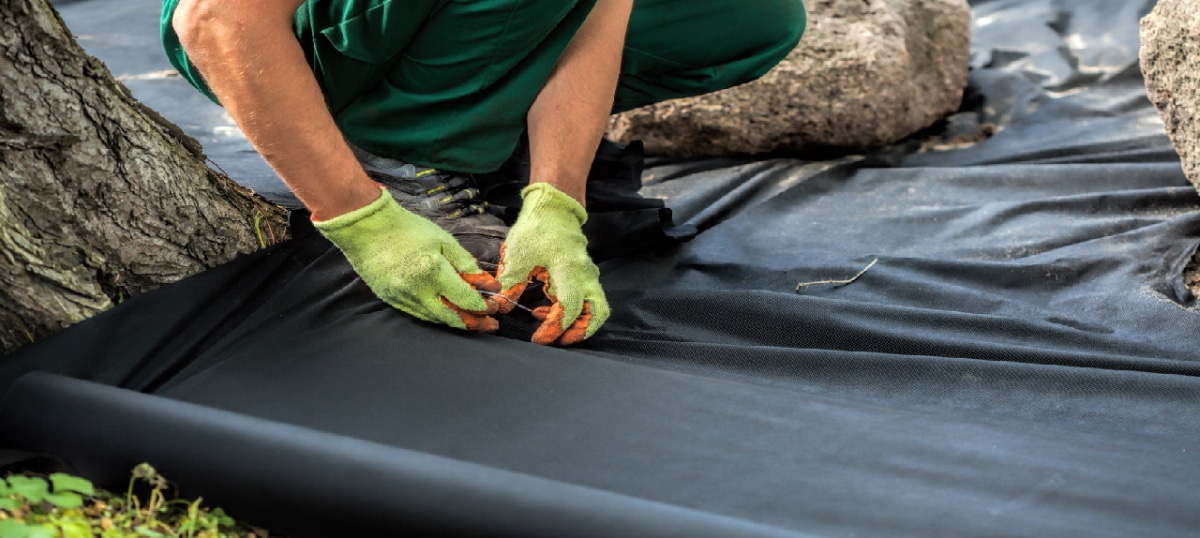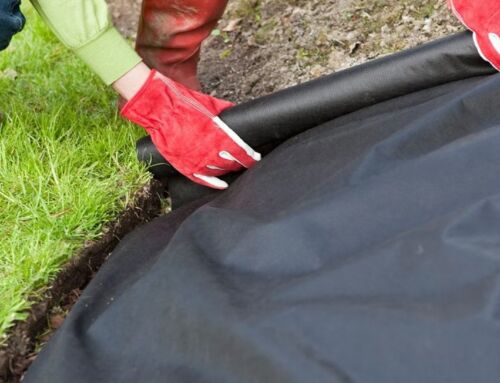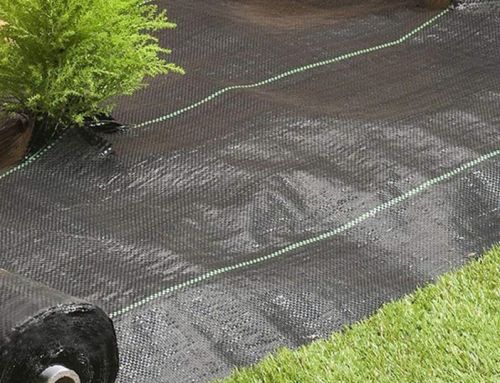If you’re looking to spruce up your outdoor space, laying rocks in your garden can be an eye-catching and functional choice.
At the same time, you don’t want sprouts and weeds to poke through and ruin the look of your rock garden.
The solution?
Landscape fabric.
With the growing interest in low-maintenance and visually appealing garden solutions, properly installed landscape fabric can help keep your outdoor space looking clean and clear.
In this guide, we’ll walk you through the essentials of choosing the right landscape fabric, preparing your site, laying the fabric correctly, and then topping it off with your choice of rocks.
We’ll also sprinkle in some expert tips to make sure your residential landscaping project stands the test of time (and weather!).
Whether you’re a seasoned gardener or new to the landscaping game, our guide aims to arm you with the knowledge and confidence to enhance your outdoor space effectively.
By the end of this article, you’ll have a clear understanding of how to install landscape fabric under your Sydney rock garden, ensuring a weed-free, visually appealing, and durable rock landscape.
What is Landscape Fabric?
Landscape fabric, also known as weed barrier fabric, is a permeable textile made from synthetic or organic materials, designed to let water and air through while keeping weeds at bay.
Incorporating landscape fabric under rocks significantly reduces weed growth, cutting down on maintenance time and ensuring that your garden remains pristine.
This is particularly valuable in Sydney’s diverse climate, where seasonal rains can promote rapid weed growth.
Landscape fabric also aids in soil moisture retention, providing a healthier environment for surrounding plants and trees by allowing water to seep through to the roots, rather than running off or evaporating.
How to Install Landscape Fabric Around Trees
Another notable advantage is erosion control.
In areas prone to heavy rains, like many parts of Sydney, landscape fabric can prevent soil from washing away, preserving your garden’s structure and the nutrient-rich topsoil essential for other plants to thrive.
Landscape fabric acts as a stabiliser for the rocks, preventing them from sinking into the soil over time and maintaining the aesthetic and functional aspects of your landscaping project.
The use of landscape fabric also contributes to a more eco-friendly gardening approach.
By reducing the need for chemical weed killers and fertilisers, it helps maintain the natural balance of your garden, making it safer for local wildlife and reducing your environmental footprint.
Environmental Considerations and Regulatory Compliance
The use of landscape fabric, though beneficial for weed control and soil stability, carries potential environmental implications.
Synthetic fabrics, while durable, are not biodegradable and can contribute to plastic pollution if not properly managed at the end of their lifecycle.
On the other hand, organic fabrics offer a more eco-friendly alternative, breaking down over time without leaving harmful residues.
Their shorter lifespan might require more frequent replacements. Choosing a landscape fabric that balances durability with environmental sustainability is key.
It’s also important to consider the permeability of the fabric and rocks chosen, as improper installation can lead to water runoff issues, affecting local waterways and wildlife habitats.
Tailoring our Landscape Fabric to Your Space
Start by Assessing Your Property’s Needs
Consider factors such as:
- Sunlight and Shade: Different areas of your garden may receive varying amounts of sunlight throughout the day. This can influence not only the type of plants that will thrive alongside your rock installation but also the choice of landscape fabric, as some materials may degrade more quickly under intense sunlight.
- Soil Type and Drainage: Understanding your soil type and its drainage capacity is crucial. Certain soils may require additional preparation or specific types of landscape fabric to ensure proper water filtration and prevent erosion.
- Aesthetic and Functional Goals: Are you aiming for a purely decorative rock garden, or are there functional aspects, such as a pathway or erosion control, to consider? Your goals will determine the layout, the type of rocks, and the landscape fabric best suited to your project.
Gather Tools and Resources
Essential tools for laying landscape fabric and rocks typically include:
- Garden Gloves: Protect your hands from sharp rocks and rough materials.
- Spade and Trowel: For digging and fine-tuning the soil bed before laying the fabric.
- Landscape Fabric: Choose a fabric that suits the environmental conditions and longevity requirements of your project.
- Rocks: Select sizes and types that complement your garden’s aesthetic and functional needs.
- Landscape Staples: To secure the fabric to the soil and prevent it from shifting.
- Utility Knife: For cutting the landscape fabric to size.
- Wheelbarrow: To transport rocks to the site.
- Rake: For smoothing out the soil and distributing rocks evenly.
A Guide to Quality Materials and Tools
Landscape Fabric
The cornerstone of your project, landscape fabric, needs to be effective at weed suppression while allowing water and air to reach the soil. There are generally two types of landscape fabric:
- Woven Landscape Fabric: Ideal for high-traffic areas due to its durability. It’s suitable for under pathways or large rock installations.
- Non-Woven Landscape Fabric: Best for plant beds as it’s more permeable, promoting better air and water flow to plant roots.
Recommended Brands: Look for brands that balance durability with environmental friendliness. Locally, Geofabrics and Bidim offer products that are widely respected for both residential and commercial projects.
Rocks
Rocks add texture, colour, and structure to your garden. In Sydney, you have a wide selection of local and imported rocks to choose from:
- River Stones: Smooth and rounded, perfect for creating natural-looking landscapes.
- Gravel: Ideal for pathways or as a top layer over landscape fabric in plant beds for improved drainage and aesthetics.
- Larger Rocks and Boulders: Create focal points or natural barriers in your garden.
Step-by-Step Installation Guide
Step One: Plan and Design
- Safety Precaution: Wear gloves and protective footwear when handling rocks and tools.
- Best Practice: Sketch your design on paper, including the placement of rocks and plants. Consider sunlight, drainage, and visual appeal.
Step Two: Prepare the Area
- Safety Precaution: Check for underground utilities before digging. In Sydney, dial the national Dial Before You Dig service for information.
- Best Practice: Remove weeds, debris, and any existing vegetation. Level the ground using your rake and ensure proper drainage by creating a slight slope if necessary.
Step Three: Measure and Cut Landscape Fabric
- Safety Precaution: Use a utility knife with a retractable blade to avoid cuts. Cut the fabric on a stable surface.
- Best Practice: Overlap strips of fabric by at least 10-15 cm to prevent weeds from finding their way through gaps.
Step Four: Secure Landscape Fabric
- Safety Precaution: When using landscape staples, press them firmly into the ground to avoid tripping hazards.
- Best Practice: Secure the fabric edges well, especially around the perimeters and where pieces overlap, to prevent it from shifting.
Step Five: Arrange and Lay Rocks
- Safety Precaution: Lift with your legs, not your back, when moving heavy rocks. Use a wheelbarrow for transport.
- Best Practice: Place larger rocks first as focal points, then fill in with smaller stones and gravel. For pathways, ensure the gravel is evenly spread and compacted.
Step Six: Maintenance and Upkeep
- Best Practice: Inspect the fabric and rock placement periodically for any shifts or exposure. Pull any weeds that sprout.
When to Call in the Professionals
While many aspects of installing landscape fabric and rocks are manageable for DIY enthusiasts, certain scenarios require professional expertise.
If your project involves extensive earthworks, complex designs, or the handling of very large rocks, consulting with a professional landscaper is advisable.
If you encounter issues with severe drainage or erosion, professional landscapers can provide solutions that go beyond the scope of basic DIY capabilities.
The team at Manna Landscapes have the necessary equipment and knowledge and understands local regulations to ensure your project complies with Sydney’s specific guidelines and codes.
How Much Does Landscape Fabric Cost?
| Item | Description | Estimated Cost |
|---|---|---|
| Landscape Fabric | Per square metre, depending on quality and type. | $1.50 – $4.00 |
| Rocks | Cost varies greatly by type (e.g., river stones, gravel). Price per tonne or cubic metre. | $50 – $200 |
| Tools & Supplies | Includes spades, trowels, gloves, landscape staples, utility knife. | $100 – $300 |
| Professional Installation | Optional, based on per square metre or hourly rate. | $50 – $100/hr |
| Transport & Delivery | If applicable, for large quantities of rocks. | $50 – $150 |
Note: Prices are estimates and can vary based on location, supplier, and the scale of your project.
Trust Manna Landscapes For Your Next Garden Project
At Manna Landscapes, our commitment to avoiding costly errors and delivering impeccable results stands us apart as industry leaders.
Here’s why we’re a trusted partner for homeowners throughout Sydney:
- Experience and Expertise: With decades of experience in Sydney’s unique landscape, our expertise is unmatched.
- Attention to Detail: We understand that the devil is in the details. From the initial design to the final touches, every step is meticulously planned and executed.
- Commitment to Sustainability: We prioritise eco-friendly practices and materials, contributing to a greener, more sustainable Sydney.
- Avoiding Costly Errors: Our experience and professionalism mean we foresee and navigate potential pitfalls, saving you time and money.
- Tailored Solutions: Recognising that each space and client is unique, we customise our approach to meet your specific needs and dreams.
Let us transform your garden into a testament to timeless beauty and enduring quality, where every stone is a reflection of our commitment to perfection.
Contact Manna Landscapes today for a personalised consultation or FREE quote



